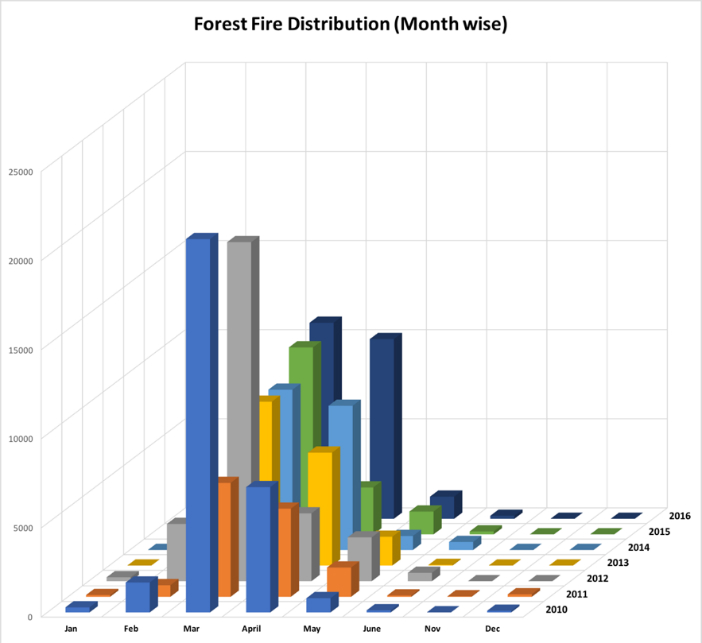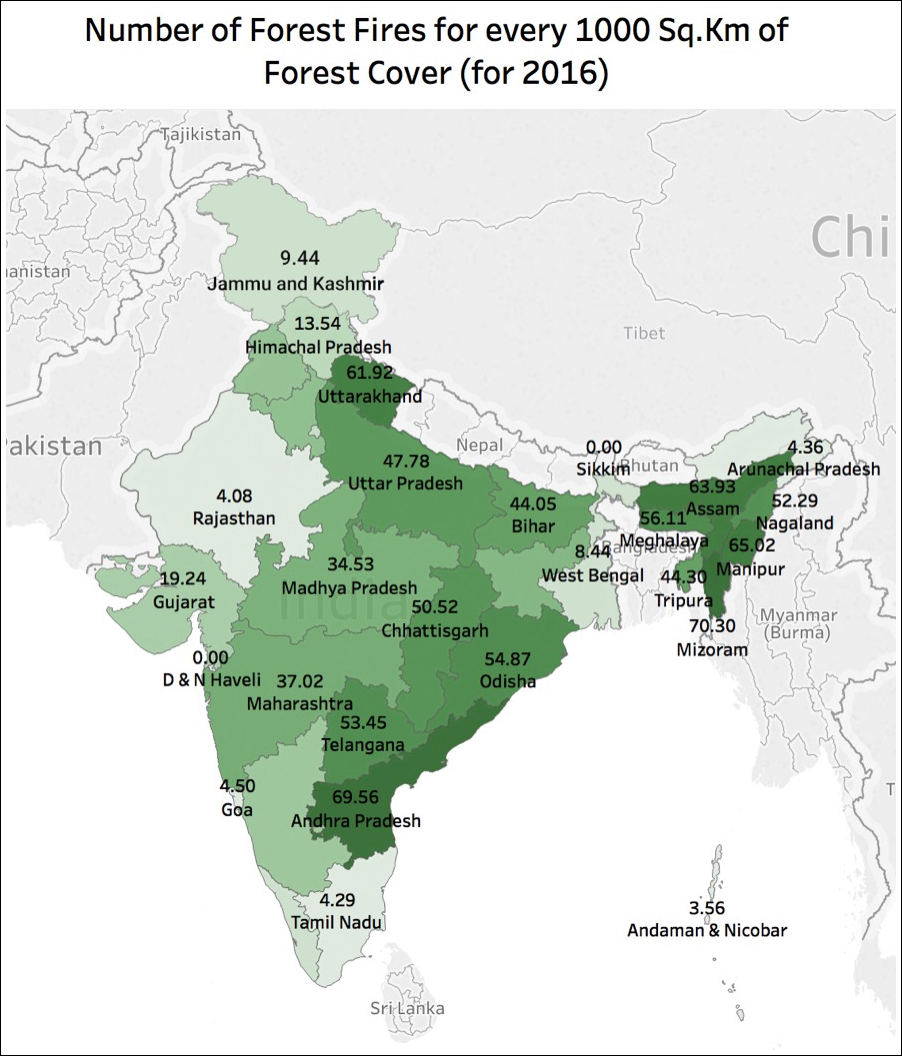[orc]The number of forest fires in India has seen a mixed trend over the last few years. Various reports and analysis suggest that we are long way away from tackling this problem
India’s forest cover is remarkably distinctive. Though the country accounts for less than 2% of the world’s total forest cover, it encompasses a diverse range of 16 major forest types and 10 biogeographic zones. This precious entity also disproportionately supports a burgeoning 18% of the world’s population and must offset the carbon emissions of the world’s third largest carbon emitter. It is therefore imperative for India to protect its forest cover and enlarge it. While attention is drawn to the umbrella issue of diversion of forest lands, little is known to the public about the ravages of forest fires. This piece provides an overview of the number of forest fires recorded by the Forest Survey of India between the years 2010 and 2016.
Forest Fires see a mixed trend
Forest fires in the Indian subcontinent were typically natural phenomenon caused by lightning and the circumstances of low humidity, high temperatures and dry vegetative cover. However, with mankind discovering fire and utilizing it as a tool to serve its own purpose anthropogenic reasons predominantly began to inflame forest fires. Over the past few centuries the ever-increasing demands of industry, urbanization, economy and society have led to the rampant incidence of forest fires and 99% of India’s forest fires are reported to originate due to anthropogenic reasons.
Most of these anthropogenic causes are typically attributed to communities whose socio-economic circumstances or cultural histories are closely tied to the forests. Therefore, the need for cattle fodder, collection of non-timer forest products, collection of tendu and mahua leaves, shifting cultivation, poaching, warding off wild animals and small-scale agricultural farming are generally cited as causes of forest fires. Additionally, pilgrim and tourist carelessness are cited as reasons. It is important to note that official records do not report the causes of forest fires and there is no precise data on the issue. Therefore, it is difficult to substantiate the claim that these are the most common causes of forest fires. It is also reported by some sources that forest fires are created to conceal illicit timber extraction and tree felling but there remains an absence of public data to substantiate this claim. Forest fires are occasionally believed to be used as mediums of protest restrictive government policies and by officials themselves to maintain grasslands for herbivores. Kindling or setting fire in reserved forests is prohibited by the Indian Forests Act, 1927 under which the offenders can be imprisoned for a maximum of 6 months or be fined up to Rs 500 in addition to compensating for the loss.
The number of forest fires in India saw a mixed trend in the last 7 years. From a high of 30947 fires in 2010, the number decreased to 13791 in 2011 only to increase to 29194 the following year. In 2016, the number of forest years increased to 24817 from 15937 in the previous year (2015).

The real time monitoring of forest fires is achieved by a collaboration between the Forest Survey of India and ISRO’s National Remote Sensing Centre (NRSC) whereby Indian Remote Sensing satellites provide systematic data on active fires and this information is disseminated to the local forest officials within 2 hours.
March & April account for 85% of all the fires
Of all the months in the last 7 years (2010 to 2016), March alone accounted for 57% of all the forest fires followed by April (29%). February & May together accounted for about 13% of all the fires while all the other months put together contributed to about 1% of all the fires.

Forest fires are repeatedly cited as majorly contributing to the depletion of India’s forests which function as invaluable carbon sinks. Additionally, forest fires release high emissions of carbon and aerosols into the atmosphere. They also result in loss of biodiversity, loss of vegetative cover which consequently leads to soil erosion and water run-off, loss of livelihood for dependent communities, alteration of soil composition, loss of timber resources, change in micro-climate, health issues, disturbance to wildlife and adverse changes in the regenerative capacity of forests. Thus, they amount to massive ecological and economic damage, although details regarding the same are not maintained by the government.
35% of the forest fires occur in the North-East
The North-Eastern states account for more than 35% of all the forest fires between 2010 and 2016. Mizoram accounted for 16818 fires during this period, the highest for any state in the country. Five north-eastern states are in the list of top 10 states that accounted for the highest number of forest fires during this period. Odisha, Chhattisgarh, Andhra Pradesh, Madhya Pradesh & Maharashtra are the remaining five states in the top 10. The top 10 states accounted for nearly 75% of all the fires in these 7 years.

Forest Fire Management
Forests are Entry 17-A in the Concurrent List (Seventh Schedule) of the Indian Constitution. The responsibility of forest fire management is shared between the Central and the State governments. While the Central government provides policy, technical support and finances, the implementation of programs and suppression of forest fires is the responsibility of the State governments. State governments also have the duty to restore the burnt forest areas through afforestation and other conservation methods.
The National Forest Policy of 1988 urges for the developing of capacities to deal with forest fires but does not provide any substantial guidelines on forest fire management. The Draft National Forest Policy of 2016 states that “Adequate measures should be taken to safeguard ecosystems, map the vulnerable areas and develop and strengthen early warning systems and methods to control fire based on remote sensing technology and community participation”.
The Central government allocates funds to States and Union Territories under the Centrally Sponsored Scheme Intensification Of Forest Management to create fire lines, construct fire watchtowers, build water storage structures and implement other measures. The Ministry of Environment, Forest and Climate Change also stated that it has formulated a contingency plan to coordinate during a major forest fire crisis.
However the state of forest fire management, which includes both mitigation and suppression, remains lacking. According to the National Institute of Disaster Management’s Forest Fire Disaster Management the lack of appropriate policy, institutional mechanism, scientific approach to data collection and management, funding, involvement of local communities, coordination, prevention and preparedness have hindered the capacity to manage forest fires.
The destruction of economic and ecological wealth by forest fires is an avoidable tragedy and deserves priority for forests and natural resources cut across all sectors of development.

Featured Image: Forest Fires in India


